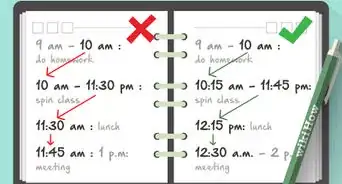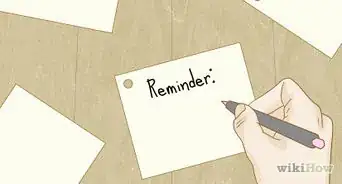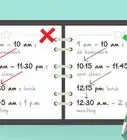X
wikiHow is a “wiki,” similar to Wikipedia, which means that many of our articles are co-written by multiple authors. To create this article, 9 people, some anonymous, worked to edit and improve it over time.
This article has been viewed 115,513 times.
Learn more...
Are you having a hard time sticking to schedules? That's a problem many people have, but luckily you can organize and make a schedule that works. Follow the plan that helps you grow everyday!
Steps
-
1Make a list of all the things you absolutely have to do during the day. This includes school, work, etc. These will be the things that have to be done at a certain time every day, and the times for which you do them cannot be moved around or rescheduled. Ideally, this list should be relatively short.[1]
-
2Make a list of things you do that need to be done. This includes exercising, studying, chores, shopping, personal hygiene, and so on. These are things that you need to do, but can be moved around a bit on your schedule for your convenience.[2]Advertisement
-
3List all the things you would like to do, but are usually considered free time activities. This includes reading, socializing, watching TV, video games, etc.
-
4Go through and fill in the tiny details of all of your daily activities. For example, if you've written down "6:00 PM - Revision", turn it into "6:00 PM - Revision - Chapter 7 Science, make flashcards + review vocabulary".[3]
-
5Decide on the order of your daily activities. Of course, go ahead and add all of step 1 activities first, then step 2's, and last but not least, step 3's.[4]
-
6Decide in what times of day you'll do each activity. Spending 1-2 hours per step 2 and 3-type activities is ideal, but do what's best for you.[5]
-
7Buy a planner/agenda/organizer. After you have your ideal schedule in mind, you'll know what type of agenda is best for you. Remember, don't worry about what the cover of the planner looks like so much as if it has what you need in the contents on the inside. Worst case scenario, you could turn it into a DIY project if the cover isn't your style. Explore different layouts as not all planners are the same. There are different planners for different uses, so do your research.[6]
-
8Be realistic. Now that you've made your schedule, you're going to need to stick to it, which is going to be the most difficult part. You can't expect to cram 100 activities into 24 hours. If you have more activities to do than what you have time for, you have two options: Either have 2 different schedules that alternate between days (for example, Monday - Schedule 1, Tuesday - Schedule 2, Wednesday - Schedule 1, and so on) or you really need to prioritize and/or compromise based on your own personal daily routine. Only you can decide the best action to take here. But the whole point of this step is to make sure your schedule is possible to stick to, so make sure you do that by taking one or both of the options listed above and allowing enough, but not too much time, for each activity.
-
9Motivate yourself. Be conscious of why you wanted to stick to a schedule in the first place and keep it in your mind. Also be aware of the consequences should you fail to keep a schedule, and the rewards if you are successful. Some pros of keeping a schedule: be more organized, resulting in less stress, can help you be more responsible, make you feel in control of your life, help you be successful in your business, work, school, and/or every day life, etc.[7]
-
10Don't give up. We all fall off the wagon sometimes, so if you don't get it right straight away, don't fret. Identify where you went wrong and try a new strategy. It could take months to get your schedule where you are happy with it and where you can finally stick to it. It's definitely a learn-as-you-go-type experience, but it's well worth it in the end, when you've finally got everything worked out.[8]
Advertisement
Community Q&A
-
QuestionWhat can I do if I'm too lazy to stick to my schedule?
 Tom De BackerTop AnswererWe're all lazy. Every invention mankind has ever made was to reduce the effort a certain task costs. I would suggest that you accept that it's OK to be lazy sometimes, and even plan it in your schedule. My lazy day is Thursday - that evening I don't plan anything, no chores, no tasks no nothing. So all other days I can say "all right, I'll do this now because Thursday I can be lazy". However, remind yourself why you made your schedule, what your goals are, and let that motivate you.
Tom De BackerTop AnswererWe're all lazy. Every invention mankind has ever made was to reduce the effort a certain task costs. I would suggest that you accept that it's OK to be lazy sometimes, and even plan it in your schedule. My lazy day is Thursday - that evening I don't plan anything, no chores, no tasks no nothing. So all other days I can say "all right, I'll do this now because Thursday I can be lazy". However, remind yourself why you made your schedule, what your goals are, and let that motivate you. -
QuestionWhat should I do if I get distracted?
 Alix NaumovaCommunity AnswerPut all possible distractions away. Put electronics on a high shelf or give them to someone you trust. Study in one hour stretches and give yourself 10 minute break periods.
Alix NaumovaCommunity AnswerPut all possible distractions away. Put electronics on a high shelf or give them to someone you trust. Study in one hour stretches and give yourself 10 minute break periods. -
QuestionHow do I concentrate on sticking to my schedule?
 Community AnswerLimit distractions. If you find yourself wanting to use your phone, for example, give to a friend or family member until you've completed your tasks.
Community AnswerLimit distractions. If you find yourself wanting to use your phone, for example, give to a friend or family member until you've completed your tasks.
Advertisement
Things You'll Need
- A sheet of paper
- Writing utensil
- Agenda/Planner/Organizer
References
- ↑ https://www.indeed.com/career-advice/career-development/create-a-daily-schedule
- ↑ https://www.entrepreneur.com/living/want-to-be-successful-stick-to-a-schedule/234145
- ↑ https://www.indeed.com/career-advice/career-development/create-a-daily-schedule
- ↑ https://www.northshore.org/healthy-you/how-to-start-a-new-routine-and-stick-to-it/
- ↑ https://www.indeed.com/career-advice/career-development/create-a-daily-schedule
- ↑ https://www.entrepreneur.com/living/want-to-be-successful-stick-to-a-schedule/234145
- ↑ https://ca.indeed.com/career-advice/career-development/how-do-i-create-and-stick-to-daily-schedule
- ↑ https://kidshealth.org/en/teens/motivation.html
About This Article
Advertisement
































































